Abstract
Architecture, designs experiences through movements and materials to explore and expand the memory. Cinema mirrors these experiences, by representing the architecture in movies. Alain Resnais’s film Last Year at Marienbad stems from this relationship between the notions of time, space and memory. The approach of this puzzling film, problematized the space-time relation by questioning the reliability of memory and opened room to raise questions about spatial perception: How do we perceive the perception of time and space in films? How can that ambiguous relation between time and space be translated in spatial terms? In this paper, these questions will be discussed in the scope of this film through a close reading with the inquiries of Henri Bergson and Gilles Deleuze with their inter-disciplinary perspectives in order to extend this inter-sensory interval. As a conclusion, the interaction of this relation will be reviewed.
Keywords: Architecture, Cinema, Duration, Memory, Perception.
1. Introduction
The relationship between architecture and cinema has emerged in the late 19th century — starting right after the emergence of cinema both as an art form and a communication tool, and became more visible in the 20th century, with the technological developments and extending distribution networks. The shift in the individual and collective life style following the industrial revolution had a progressive effect on architecture and accordingly on the representation of architecture in cinema. As two disciplines that operate through space, time and movement, architecture and cinema constituted a common ground. Although they have their own tools, methods, processes and processing that lets the world to be ‘experienced’, these principals have a recurring effect on each other. By the virtue of films, we partake of a landscape within a timescape, which showcases how others partake of a landscape within a timescape. This process of constant invention of architecture through film and constructing the experience through architecture at different scales is possible because of cinema’s ability to manipulate the space and time. Due to that connection between cinema and architecture, the common ground they inhabit has been subjected to studies from various disciplines. The emergence of new perspectives to look at both architecture and cinema, makes new interpretations possible. Considering their ability to create fractal memory palaces together, not only as a physical entity, a decor, a background, or a context provider, but also as an actor that spans the gap between remembrance and the perception of time, spatial quality of cinematic experience may be traced.
In this paper, the quality of cinema as a spatio-temporal practice and the role of architecture in cinema as a stimulant to memory will be investigated in detail. In the following sections, firstly, the concepts of memory, perception, time and duration in the Henri Bergson’s inquiry will be inspected. Secondly, Gilles Deleuze’s approach to the cinema within the scope of Bergson’s conceptual framework will be reviewed. After setting the frame, Last Year at Marienbad (L’Annee Derniere a Marienbad 1961) will be reviewed as a case study — by focusing to the usage of space as a mass and the representation of movement in the film — to map previously mentioned concepts. Conclusion will assess this lineage of thought in terms of space-sensitive filmic experience and focus on the possibility of extending it.
2. Background
2.1 Memory and Perception of Time in the Works of Bergson
In order to comprehend the relationship between cinema and architecture, it is crucial to look at early philosophical reflections linked to it. Henri Bergson (1859-1941) was one of the first philosophers to blend cinema into a philosophical discourse. Although it played a minor role in his oeuvre, his studies influenced many others after him. Because he witnessed the birth of the cinema, he only had a chance to observe early works produced during a single phase, and to him that phase had some features that needs to be criticized (Totaro 2001). Before addressing those objections, it is important get familiar with the concepts that shaped the overall theory of Bergson regarding the memory, perception and time.
What made Bergson’s studies import in terms of the philosophy of film, was his new metaphysical approach to the question of reality. Considering the images as the fundamental particles of ‘things’, Bergson structured a theory of time that is based on the selection and the organization of the ‘images’. This structure suggested that, every encounter with a thing and the image of it as we perceive through a special kind of image called body, is contaminated with other images in the memory. This constant and continuous contamination makes it impossible to have neither a pure perception of a thing nor a pure memory that is not affected by its image (Al-Saji 2004).
Bergson’s approach to cinema stems from this condition of contaminated reality, and the cognitive dualism about knowledge to explain time and movement. According to him, there are two ways of reaching to knowledge, through intellect — knowing things from outside —, and through intuition — knowing things from inside —. The recurring motifs of duration and space in terms memory in Bergson’s studies, draws attention to that distinction between intellect and intuition. For Bergson, these two systems of knowledge work independently in comprehending the world as it is. The first one, offers practical and relativity based perspective and is useful for serving in pragmatical issues of natural sciences, while the latter constituting a rather fluid process of constant becoming and provides engagements to understand the nature of things. From Bergson’s perspective, intuition doesn’t refer to an empirical reduction or a mystical anticipation. It refers to “comprehending reality by a special experience”, which requires an active participation to be achieved. According to him, reality is too complex to be perceived only through methods and precision of intellect, and the vital force it embodies needs intuition, to be fully grasped. (Bergson 2010)
He furthers this necessity of intuition in production of knowledge, to production of memory. To his understanding, memory merges from the duration which is essential to understand the perception of time. The perception of time as spatial fragments in line, as homogeneous self-contained entities that come one after the other is deceiving. This definition of time doesn’t depict time but a closed, singular space, separated from the others (Bergson 2010). According to Bergson, the durations however, are the continuous leaps between these fragments that can be multiplied infinitely, between past and present in construction of future, with the intuitive interpretations of memories as he stated:
Intuition doubtless admits of many degrees of intensity, and philosophy many degrees of depth; but the mind once brought back to real duration will already be alive with intuitive life and its knowledge of things will already be philosophy. Instead of discontinuity of moments replacing one another in an infinitely divided time, it will perceive the continuous fluidity of real time which flows along, indivisible (2010).
The indivisibility of the experience of movement from thing to image, from perception to memory, points out the indivisibility of movement. Dividing movement means spatialising it, and spatialising it means it is made of measurable, finite units. From a reversed point of view, the way of grasping the knowledge through body tells us otherwise which is also about the order of time. Since movement cannot be divided time as a movement cannot be divided too. As in a container that contains itself, as a klein bottle that has no inside or outside, no divided spatiality, the time remains remaining intact.
2.2. Cinematıc Reflections in the Works of Deleuze
Taking his cue from the inquiry by Bergson, Gilles Deleuze also invites intuitions to construct his discussion of movement and time. Accordingly he states:
Intuition is not duration itself. Intuition is rather the movement by which we emerge from our own duration, by which we make use of our own duration to affirm and immediately to recognize the existence of other durations, above or below us (Deleuze 1991).
To extend Bergson’s connotations about memory and its relation to durations, Deleuze puts cinema forward. Through his comprehensive work Cinema I: Movement-Image and Cinema II: Time-Image, he uses representative and perceptional aspects of cinematographic experience and elements in terms of time and movement.
The first one of this two volumed probe falls before the World War II and the second falls after it, shows the shift in the conveying of images through cinema (Yetişkin 2011). Deleuze’s concept of movement-image which is based on a “sensory-motor schema” — where an action produces a reaction — derives from Bergson’s consideration of cinema as a “false movement”. According to Bergson, cinema creates an illusion of homogeneous movement by dividing it into twenty-four frames per second which causes the perception of time as a homogeneous linear setting as he objected (Bergson 1984). Yet, Deleuze also objects to that assumption by drawing attention to that, movement is not a mere implication of a whole but a constant reconstruction of it via relations of the parts. In movement-image, the actions and reactions creates the image, the leap, as they impose themselves over time and by manipulating the durations. Further on Deleuze explains as:
But it has often been noted that what it [cinema] gives us is not the photogramme: it is an intermediate image, to which movement is not appended or added; the movement on the contrary belongs to the intermediate image as intermediate given. It might be said that the position of natural perception is the same. But there the illusion is possible in the corrected ‘above’ perception by the conditions which make perception possible in the subject. In the cinema, however, it is corrected at the same time as the image appears for a spectator without conditions (Deleuze 2013).
What breaks this sensory-motor schema but keeps manipulating the durations may be traced in Deleuze’s time-movement concept. Because it does not chase the patterns of action-reaction, it implies a perception of time as a collection of durations by using gaps and jumps, in order to avoid representing the time via movement but by becoming time itself. Time-images does not depict and/or contains actions and reactions, deciphers reality instead of creating o portrayal of it. The inclination of creating a successive whole through implications of reality, shifts towards utilizing the holes and gaps, the shape of distance and what seems to be invisible between those parts. It holds different extensions and/or layers of time; to combine each one of them at a single time which they are already in relation and as in Bergson’s theory of duration, these images simultaneously constructs the past and the future within a present. (Bergson 2004; Deleuze 2013) As a metaphor for crystallization of this sense of time, Deleuze refers these images as ‘crystal images’:
What constitutes the crystal-image is the most fundamental operation of time: since the past is constituted not after the present that it was but at the same time, time has to split itself in two at each moment as present and past, which differ from each other in nature, or, what amounts to the same thing, it has to split the present in two heterogeneous directions, one of which is launched towards the future while the other falls into the past. (Deleuze 2013)
According to Deleuze crystal images appears through certain motifs in films. As in Bergson’s mirror example for detailing the virtual and actual, Deleuze considers it is one of the literal clues of the time images. The reflection which stands for the virtual, and its object which stands for the actual becomes one around the event of indivisibility. The opacity and transparency of the surfaces and the relation of a seed to its environment similarly create this merge and reflection at the same time. As Deleuze emphasized, most of the films considered to bear time images, beared these motifs literally and figuratively, but Last Year and Marienbad itself as a whole, become a crystal image (Deleuze 2013).
3. Emptiness as a Mass: The Case of “Last Year at Marienbad”
Deleuze’s inquiry on the appearance of crystal images, can be interpreted through their spatial qualities too. The relation of part and the whole, the event and the scene, the permeability of the things can be seen as architectural motifs and the role of architecture in the cinematic experience may be traced within the frame of them. Starting from its invention, cinema holds the power to keep record of the space and its fleeting nature. In the early 20th century, the fascination with the modernism and cities it created, resulted as an increase in representation of cities in the movies (Alifragkis and Penz 2006). As Walter Benjamin pointed out, cinema was considered as a device that allows audience to travel, between the past and the present of a city (Benjamin 1998).
However the abilities of the cinema weren’t limited with that. Through cinema the spaces were not only represented but invented. The ability of cinema to create movement-images and time-images has turned it into a spatial practice. (Deleuze 1986; 2013)

Image 1. Last Year at Marienbad, 1961
The term time-image coined by Deleuze, became visible through Italian Neo-Realism and followed by French New Wave cinema as a result of paradigm shift caused by World War II. The inefficiency of movement-images’ linearity to represent reality as movement, resulted with a need of generating a new approach and evolved into time-images as constructed experiences. As a conclusion of such need of change and in search of the ‘new’, filmmakers and novelists teamed up with an updated approach. Alain Resnais as one of the established film-maker of French New Wave, directed Last Year at Marienbad to the script by Alain Robbe-Grillet, an established figure of New Roman, to depict the rupture between people, memory, reality, space and time (Totaro 2001).
The film took place in a Baroque chateau facing a French garden, shaped around three nameless characters: A woman ‘A’, a man ‘M’ — who is possibly the spouse of ‘A’ —, and the narrator ‘X’ — who has returned to the location to his possible affair with A —. In addition to these three characters, space comes to the forth as the fourth character. The relationship of A, M and X among other guests at a hotel, revolves around the concept of memory’s relativity and its reliability with the strong influence of space on their movements.
The film starts with a long shot at the hotel’s interior, with sound of an atonal music and with the voice of X welcoming audience to the haunted atmosphere:
I walk on, once again, down these corridors, through these halls, these galleries, in this structure of another century, this enormous, luxurious, baroque, lugubrious hotel, where corridors succeed endless corridors — silent deserted corridors overloaded with a dim, cold ornamentation of woodwork, stucco, moldings, marble, black mirrors, dark paintings, columns, heavy hangings, sculptured door frames, series of doorways, galleries, transverse corridors that open in turn on empty salons, rooms overloaded with an ornamentation from another century… (Robbe-Grillet 1962)


Image 2-3. Last Year at Marienbad, 1961
Throughout the film and in its labyrinth-like space organization, X tries to convince A, that last year they met and had an affair in this hotel — or in any other place —, and A herself arranged a rendezvous to go away with him. Yet A insistently claims that she was never there before — or in any other place — and doesn’t remember him. All the dialogues between A and X seems to be a single, total dialogue with a discreet gaze of M, but takes place at different locations and in different times (Hays 2018). The architecture of Resnais resonates with that imply, since the space where the film takes place wasn’t a single place at all. The building created by editing scenes, shot in three royal palaces in Munich and in a film studio in Paris. While it remains unclear what belongs to reality and what does not, what belongs to past, present or future, the re-composition of the space and the circular representation of it through camera movements, depicts the struggle of remembrance in such a disoriented view through crystal images as moving into the building, passing objects by in a journey between a continuous now and then.
Empty salons. Corridors. Salons. Doors. Doors. Salons. Empty chairs, deep armchairs, thick carpets. Heavy hangings. Stairs, steps. Steps, one after the other. Glass objects, objects still intact, empty glasses. A glass that falls, three, two, one, zero. Glass partition, letters, a letter lost. Keys hanging from their rings, in their assigned place, lined up in successive rows, numbered door keys. 309, 307, 305, 303, chandeliers. Chandeliers. Beads. Unsilvered mirrors. Mirrors. Empty corridors as far as the eye can see… (Robbe-Grillet 1962)
What also makes this disoriented voyage through voids in spaces and gaps in memories intriguing is the movement of characters in and between these locations, their gestures and the spatial patterns. Inside the building, with undisrupted shots, we stroll through the halls and corridors, with walls full of ornaments, overhear other people trapped in this hotel, having similar conversations about what happened last year. But mostly looking at them looking at something. This ‘look of the look’ manifests itself through usage of mirrors. While seeing the characters isolated with their own reflections or with other characters in the frame, in a parallax caused by mirrors that makes us observe the subject from different points of views, a question comes to mind: what is virtual and what is actual? As Bergson explains the difference through a mirror metaphor, the image of an entity resonates with the actual and its reflection in the mirror resonates with the past or present — since neither past nor future is independent from the present but also they are not a reduced representation or projection of it (Bergson 2004).
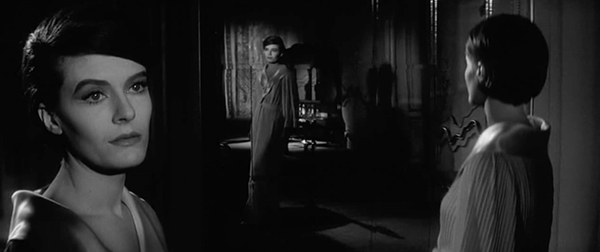
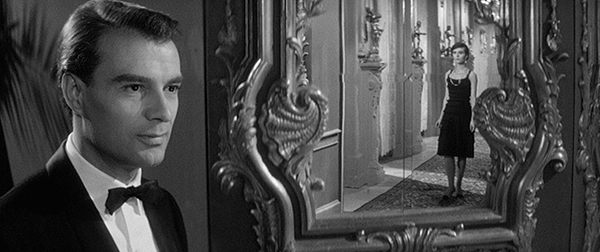
Image 4-5. Last Year at Marienbad, 1961
The exterior spaces of the hotel are no less puzzling than the interiors. The geometrical precision of the garden — where characters cast shadow but trees and statues do not — oscillates within the enigmatic timescape in the movie. Among the conversations between A and X, he mentions their meetings in the garden by referencing the statues in it and tries to persuade her that they were there. Yet the memorability of statues disappears as they appear in different locations and on “different sheets of time”, during the characters’ ongoing conversations, the landscape becomes a place to get lost (Deleuze 2013).
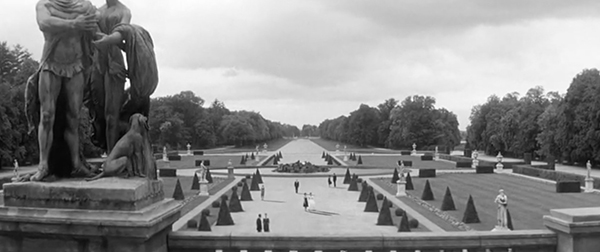
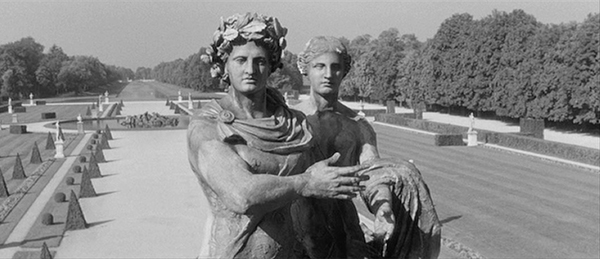
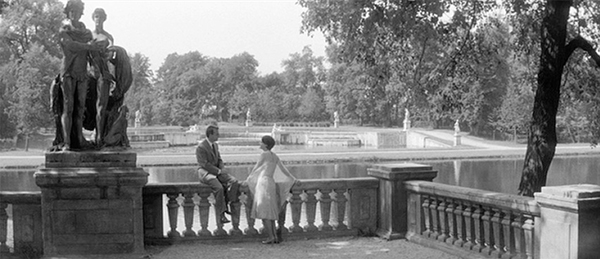
Image 6-8. Last Year at Marienbad, 1961
The encounters continue while past, present and future dissolves into each other. A watches herself walking in the garden with X, looks at her photograph that X claims he took last year, founds the hundreds of the same photographs in her room. Her room changes as her mental state changes, it gets bigger and darker. Furnitures multiply, ornaments cover the walls, as in a palimpsest, different layers of times superposes and gives way to crystal images (Deleuze 2013). At a certain point, she surrenders to X’s memory over hers. She convinces herself and agrees to leave the hotel with him, but the end lacks any obvious resolution, and leaves them walking to another configuration of time and memory, towards a continuous loop as Deleuze states:
For Resnais conceived Last Year... like his other films, in the form of sheets or regions of past, while Robbe-Grillet sees time in the form of points of present. If Last Year... could be divided, the man X might be said to be closer to Resnais, and the woman A closer to Robbe-Grillet. The man basically tries to envelop the woman with continuous sheets of which the present is the narrowest, like the advance of a wave, whilst the woman, at times wary, at times stiff, at times almost convinced, jumps from one block to another, continually crossing an abyss between two points, two simultaneous presents (Deleuze 2013).
Similar to the characters’ different locations in time determined by a shared memory, their access to it from different direction, their relativity to each other, Resnais’s and Robbe-Grillet’s approach to this merged multiplicity looks different. Even though their footprint in time and their gestures are differentiate, the space they inhabit through this crystal image keeps them connected.
4. Conclusion
Bergson’s critique of cinema was addressing the cinema at its primitive form. According to Bergson, first problematic aspect of cinema was the lack of its aura. He defended that mechanical reproduction of a film lacks the creative process and cannot be considered as an artwork. Secondly, the cinematographic duration, just like intellect, captures stable sections from the flowing reality, fragments of a whole, yet only intuition has an ability to put them together without extracting. Lastly he opposed that the cinematographical time is the spatial time that consists sections taken from a flowing reality, as in intellectual knowledge. It is an illusion created by the cinematographical mechanism, reflects an additional image that doesn’t exists among images. Hence it doesn’t occupy a space inside the duration, the real manifestation of time, because unlike the duration, filmic time contains a succession (Totaro 2001). In his Cinema I and Cinema II, Deleuze argued against these perspectives and explored the evolution of image-making process by browsing the pre-war and post-war examples of the cinema. The crisis movement-images faced, because of its hierarchical nature, resulted with a need of change in treating time that leads the way to time-images. Through this evolution, cinema gained the ability to form the “whole” through intuition, both with images in films and with films in cinema history. As in the case of Last Year at Marienbad, Deleuze drew attention to the recreation and reflection of psychological motions and their harmony with the non-representational narrative, the intentional incomprehensibility of the film with manipulation of durations may be achieved. Juhani Pallasmaa emphasizes this possibility by drawing attention to architecture’s effect on that:
Re-structuring and articulating time — re-ordering, speeding up, slowing down, halting and reversing — is equally essential in cinematic and architectural expressions. Lived space is not uniform, neutral and valueless space. One and the same event — a kiss or a murder, for instance, — is an entirely different story depending on whether it takes place in a bedroom, bathroom, library, elevator or gazebo. An event obtains its particular meaning through the time of the day, illumination, weather and soundscape (Pallasmaa 2012).
Last Year at Marienbad, may be considered as an example of that inevitable and manipulable superposition. In the film the image lingers from one perception to another with different speeds and the blurred line that divides them makes it impossible to keep track of what is virtual or actual, or who remembers what and when. While lingering through these memories in the empty rooms and endless gardens, surrounded by unfamiliar faces and statues, the difference between human and non-human, perception and percepted, inside and outside, past, present and future dissolves into each other. Architecture flows through the flow of durations on the screen. It becomes the part and the whole.
Bibliography
Alifragkis, S. and Penz, F. (2006) Spatial dialectics: montage and spatially organised narrative in stories without human leads. Digital Creativity, 17(4), pp 221-233.
Al-Saji, A. (2004) The memory of another past: Bergson, Deleuze and a new theory of time. Continental Philosophy Review, 37(2), 203-239.
Benjamin, W. (2010) The work of art in the age of mechanical reproduction, Lexington: Prism Key Press.
Bergson, H. (1984) Creative evolution, Lanham: University Press of America.
Bergson, H. (2004) Matter and memory, Massachusetts: Courier Corporation.
Bergson, H. (2010) The creative mind: An introduction to metaphysics, Massachusetts: Courier Corporation.
Deleuze, G. (1991) Bergsonism, New York: Zone Books.
Deleuze, G. (1986) Cinema 1: The movement-image, Minnesota : University of Minnesota Press
Deleuze, G. (2013) Cinema II: The time-image, London: Bloomsbury Publishing.
Hays, D. L. (2018). Knowing and Not Knowing, Moving and Not Moving, in Alain Resnais’s L’Année dernière à Marienbad (1961). Polysèmes, (19).
L’Année dernière à Marienbad (1961), Directed by Alain Resnais, France: Cocinor
Pallasmaa, J. (2012). The Existential Image: Lived Space and Architecture. Phainomenon, (25), 157-173.
Robbe-Grillet, A. (1962) Last year at Marienbad, New York: Grove Press
Schrader, P. (2018) Transcendental Style in Film: Ozu, Bresson, Dreyer, California: University of California Press
Totaro, D. (2001). Time, Bergson, and the cinematographical mechanism. Offscreen (www.offscreen.com). Montreal, 5(1), 10.
Yetişkin, E. B. (2011) Sinematografik Düşünebilmek: Deleuze’ün Sinema Yaklaşımına Giriş, İstanbul Üniversitesi İletişim Fakültesi Dergisi, (40), pp 123-141.